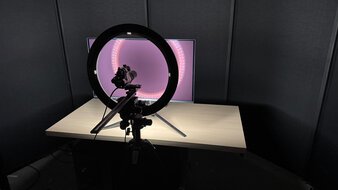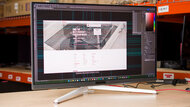
It can be difficult to decide what size gaming monitor to get when there are so many options available. Ultimately, size is a personal choice, so you should get something you feel comfortable gaming with. That said, the monitor market for each size is different, meaning the specs you tend to find on smaller monitors are different from those of larger, ultrawide gaming monitors. So besides the size, you should also think about what type of features you want, like if you want a high refresh rate or a high resolution, as choosing the right size can depend on that.
While size is one aspect we measure on each of the over 350 monitors we've tested, we also perform nearly 400 other tests to objectively measure their performance, helping you make a buying decision. If you're not sure about which size to get, you can also check out our monitor sizing guide.
In this article we help you find the best monitor size for your gaming needs. This list doesn't cover all the sizes available for gaming monitors, but simply the most common ones. You can also learn more about different sizes, aspect ratios, and resolutions of monitors and how they affect you. Also, see our recommendations for the best gaming monitors, the best 1440p gaming monitors, and the best 4k gaming monitors.
Quick Look





27-Inch Gaming Monitor
 PC Gaming9.1Console Gaming9.4Native Resolution3840 x 2160Max Refresh Rate240 HzPixel TypeQD-OLEDSize27"HDR Picture9.4SDR Picture10Response Time9.9See all our test resultsNative Resolution @ Max Hz2.7 ms
PC Gaming9.1Console Gaming9.4Native Resolution3840 x 2160Max Refresh Rate240 HzPixel TypeQD-OLEDSize27"HDR Picture9.4SDR Picture10Response Time9.9See all our test resultsNative Resolution @ Max Hz2.7 ms27-inch monitors are some of the most commonly available and popular displays. They're a good choice if you find that a 24- or 25-inch screen is too small, but you don't want anything that takes up too much space. You can find them from basic 1080p displays to high-resolution 4k screens, so you can find something no matter the type of gamer you are. Monitors of this size are also available with different refresh rates, going as high as 480Hz.
The ASUS ROG Swift OLED PG27UCDM is the best 27-inch gaming monitor we've tested. It has a 4k resolution and a 240Hz refresh rate, making it outstanding for PC gaming. Thanks to its near-instantaneous response time, it delivers extremely sharp motion, so there's no blur behind fast-moving objects. Its QD-OLED panel also provides outstanding picture quality with vivid colors and deep blacks. It has USB-C connectivity and a KVM switch, making it easy to multitask with different computers, too. Other lower-end 27-inch monitors include the 1440p ASUS ROG Strix OLED XG27AQDMG and the 4k Acer Nitro XV275K P3biipruzx, which has Mini LED backlighting, so there are plenty of options to choose from.
32-Inch Gaming Monitor
 PC Gaming9.1Console Gaming9.2Native Resolution3840 x 2160Max Refresh Rate240 HzPixel TypeQD-OLEDSize32"HDR Picture9.4SDR Picture10Response Time9.9See all our test resultsNative Resolution @ Max Hz2.7 ms
PC Gaming9.1Console Gaming9.2Native Resolution3840 x 2160Max Refresh Rate240 HzPixel TypeQD-OLEDSize32"HDR Picture9.4SDR Picture10Response Time9.9See all our test resultsNative Resolution @ Max Hz2.7 msIf you want something bigger than a 27-inch monitor for more screen space, a 32-inch display is the best gaming monitor size for your needs. This monitor size is growing in popularity and availability, and there are plenty of options with 1440p or 4k resolutions. Those with a 4k resolution tend to be designed with console gamers in mind, as they have HDMI 2.1 bandwidth to take full advantage of the PS5 and Xbox Series X|S, and they're also great choices for PC gaming at a high resolution. However, there aren't as many good budget-friendly displays in this size, so it's better to go for a smaller display if you're on a tighter budget.
If you want the best 32-inch gaming monitor, check out the ASUS ROG Swift OLED PG32UCDM. It's a premium display that's ideal for both PC and console gaming, thanks to its high refresh rate and resolution. The ASUS provides outstanding picture quality on its QD-OLED display, with bright highlights, vivid colors, and Dolby Vision support. It also has great connectivity, as it delivers up to 90W of power and has a KVM switch, which can be helpful if you have two PCs connected to the monitor. If you're looking to save a bit of money but still want a QD-OLED, consider the Dell Alienware AW3225QF. It also has Dolby Vision support and the same outstanding picture quality as the ASUS, though it differs in having a curved screen.
34-Inch Gaming Monitor
 PC Gaming9.1Console Gaming9.1Native Resolution3440 x 1440Max Refresh Rate240 HzPixel TypeQD-OLEDSize34"HDR Picture9.5SDR Picture10Response Time9.9See all our test resultsNative Resolution @ Max Hz2.8 ms
PC Gaming9.1Console Gaming9.1Native Resolution3440 x 1440Max Refresh Rate240 HzPixel TypeQD-OLEDSize34"HDR Picture9.5SDR Picture10Response Time9.9See all our test resultsNative Resolution @ Max Hz2.8 msAlthough there are bigger screens than 32 inches that maintain a 16:9 aspect ratio, these monitors are less common. Instead, 34-inch displays with a 21:9 aspect ratio, known as ultrawide, are more popular and easier to find. Most ultrawide displays of this size have a 3440x1440 resolution, and while 38-inch monitors are available, the market for them is limited. Ultrawide monitors are best suited for immersive games as you can see more at once than on narrower displays, even if there's less physical screen space than on a 32-inch, 16:9 display.
The best 34-inch ultrawide gaming monitor we've tested is the MSI MPG 341CQPX QD-OLED. It's an amazing gaming monitor with a QD-OLED panel, like the MSI MPG 271QRX QD-OLED and the MSI MPG 321URX QD-OLED, that delivers both a fast response time and remarkable picture quality. It also has the same 240Hz refresh rate as the ASUS ROG Swift OLED PG32UCDM, which is great for fast-paced games. If you don't need the highest refresh rate but still want an ultrawide QD-OLED, check out the Dell Alienware AW3423DWF instead, which you can sometimes find for less. That said, it also has a few fewer features than the 341CQPX.
49-Inch Gaming Monitor
 PC Gaming9.1Console Gaming8.2Native Resolution5120 x 1440Max Refresh Rate240 HzPixel TypeQD-OLEDSize49"HDR Picture9.5SDR Picture10Response Time9.8See all our test resultsNative Resolution @ Max Hz3.8 ms
PC Gaming9.1Console Gaming8.2Native Resolution5120 x 1440Max Refresh Rate240 HzPixel TypeQD-OLEDSize49"HDR Picture9.5SDR Picture10Response Time9.8See all our test resultsNative Resolution @ Max Hz3.8 msWhile most gaming monitors are available with 34-inch screens or smaller, a handful of models have larger screen sizes, mainly in the 40- to 49-inch range. Not all large monitors are the same, but they're great if you want an immersive gaming experience and have space for such a large screen. These are also a good alternative to a multi-monitor setup. The market for bigger displays is more limited than for smaller ones, but it has grown in the last few years.
If you want a 49-inch super ultrawide monitor, the Samsung Odyssey OLED G9/G95SC S49CG95 is the best one we've tested, as it has a fast 240Hz refresh rate. It has a super ultrawide 32:9 aspect ratio, providing even more horizontal screen space than the MSI MPG 341CQPX QD-OLED, and it also features a QD-OLED panel with outstanding picture quality and crisp motion handling. It isn't the only super ultrawide monitor available, as you can even look into the Samsung Odyssey Neo G9/G95NA S49AG95, which has the same 240Hz refresh rate. It uses Mini LED backlighting that gets brighter than the OLED G9, so it's better to use in a really bright room.
24-25 Inch Gaming Monitor
 PC Gaming7.2Console Gaming5.7Native Resolution1920 x 1080Max Refresh Rate360 HzPixel TypeIPSSize25"HDR Picture4.7SDR Picture6.3Response Time7.7See all our test resultsNative Resolution @ Max Hz1.8 ms
PC Gaming7.2Console Gaming5.7Native Resolution1920 x 1080Max Refresh Rate360 HzPixel TypeIPSSize25"HDR Picture4.7SDR Picture6.3Response Time7.7See all our test resultsNative Resolution @ Max Hz1.8 msThe smallest size you can get now for modern gaming monitors is 24 or 25 inches, and even though there are some smaller displays available, like portable monitors, they aren't as good for gaming. Getting a monitor of this size is ideal if you don't have a ton of desk space, and it's helpful if you want to see everything within your field of vision without moving your eyes too much. Gaming options in this size tend to have high refresh rates with a 1080p resolution, which makes them ideal for competitive gaming, and the low resolution isn't too demanding on your graphics card either.
The best 25-inch monitor we've tested is the Dell Alienware AW2523HF. Like most monitors in this size range, it's meant for esports gaming as it has a high 360Hz refresh rate and VRR support to reduce screen tearing. It has a consistently fast response time at any refresh rate, so fast-moving objects look sharp. It doesn't cost much either, but if you're on a tighter budget, the ViewSonic XG2431 is another great 24-inch monitor, but it has a lower 240Hz refresh rate than the Dell.
Recent Updates
Replaced the MSI MPG 271QRX QD-OLED with the ASUS ROG Swift OLED PG27UCDM, as it has a more detailed image. Replaced the MSI MPG 321URX QD-OLED with the ASUS ROG Swift OLED PG32UCDM, as the MSI is harder to find right now.
To be consistent with other articles, we replaced the Samsung Odyssey OLED G8/G80SD S32DG80 with the MSI MPG 321URX QD-OLED in the 32-inch category. We also introduced a new format to the article and updated the text to reflect these changes.
Replaced the Gigabyte AORUS FO27Q3 with the MSI MPG 271QRX QD-OLED, as the Gigabyte is harder to find. Replaced the Dell Alienware AW3423DWF with the MSI MPG 341CQPX QD-OLED, as the MSI has a higher refresh rate.
Sep 16, 2024: We replaced the Dell Alienware AW2524H with the Dell Alienware AW2523HF because the AW2524H is hard to find. We also replaced the Dell Alienware AW3225QF with the Samsung Odyssey OLED G8/G80SD S32DG80 in the 32-inch category for consistency with other recommendations.
Jun 28, 2024: Replaced the Dell Alienware AW2725DF with the Gigabyte AORUS FO27Q3 as 'Best 27-Inch', as it has HDMI 2.1 bandwidth, a KVM switch, and costs less.
All Reviews
Our recommendations are based on what we think are the best gaming monitor size options. They're adapted to be valid for most people. The rating is based on our review, factoring in price and feedback from our visitors.
If you would prefer to make your own decision, here is the list of all of our monitor reviews. Be careful not to get too caught up in the details. Most monitors are good enough to please most people, and the things we fault monitors on are often not noticeable unless you really look for them.
Comments
Best Monitor Sizes For Gaming: Main Discussion
What do you think of our picks? Let us know below.
Looking for a personalized buying recommendation from the RTINGS.com experts? Insiders have direct access to buying advice on our insider forum.
We’ve just released a new video that mentions the Samsung Odyssey Neo G8 S32BG85 here.










































































